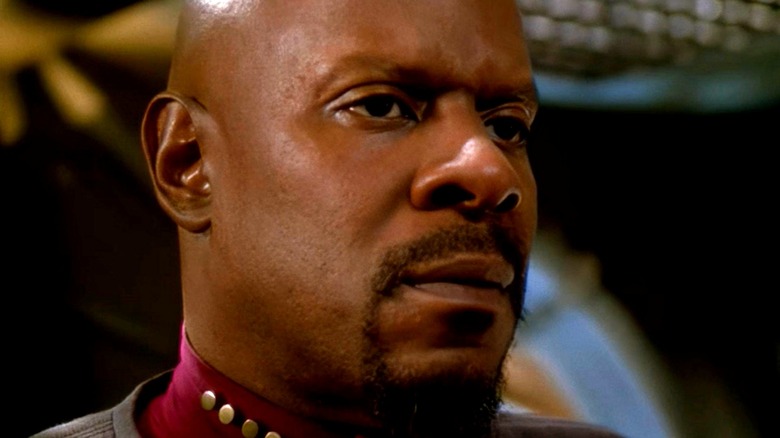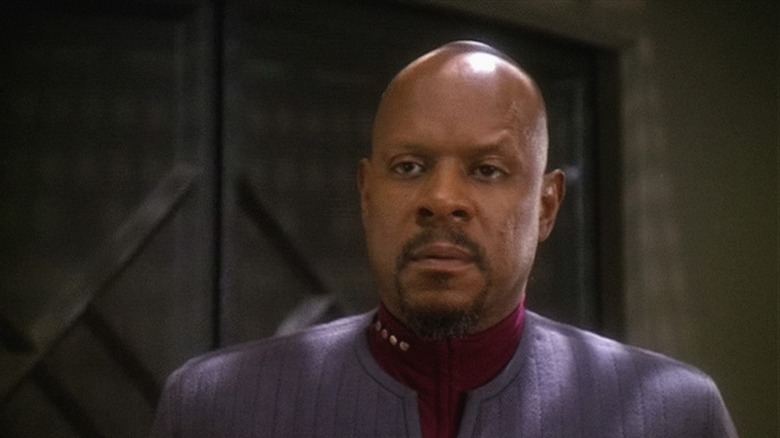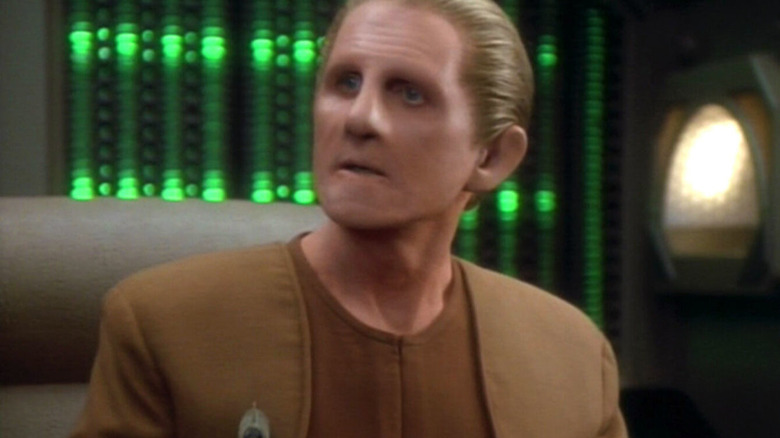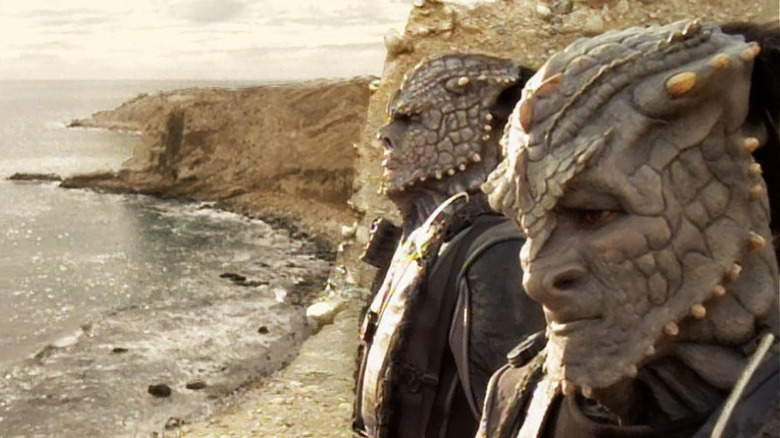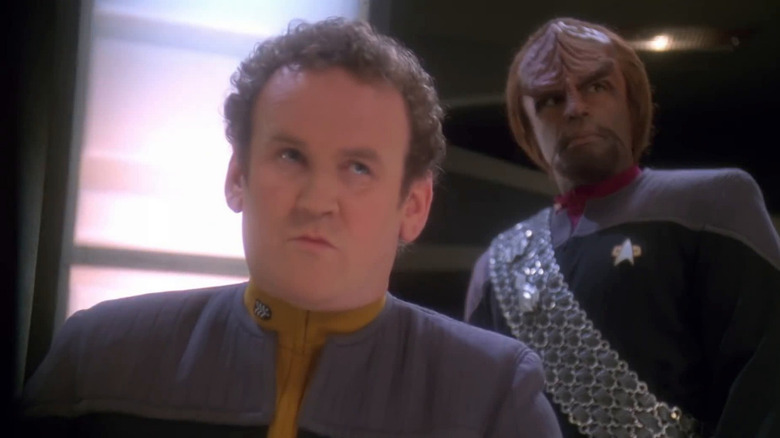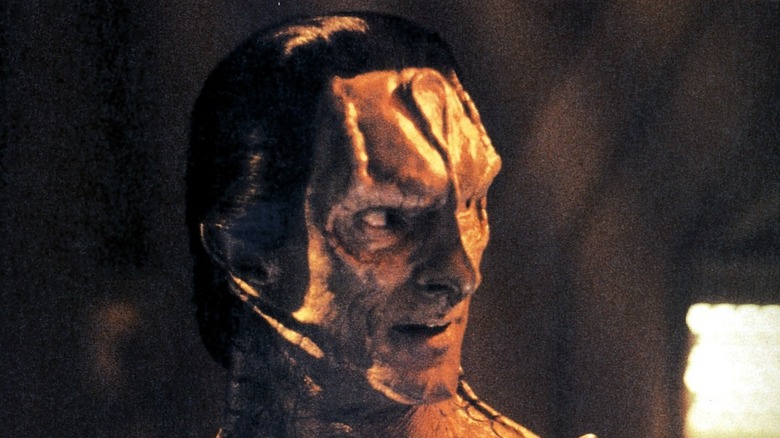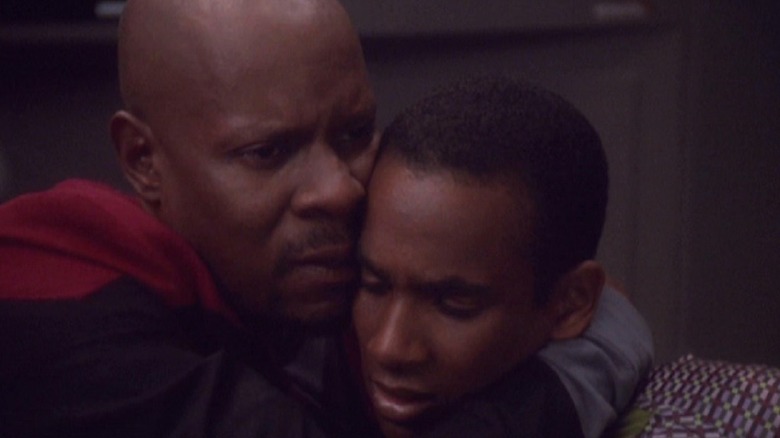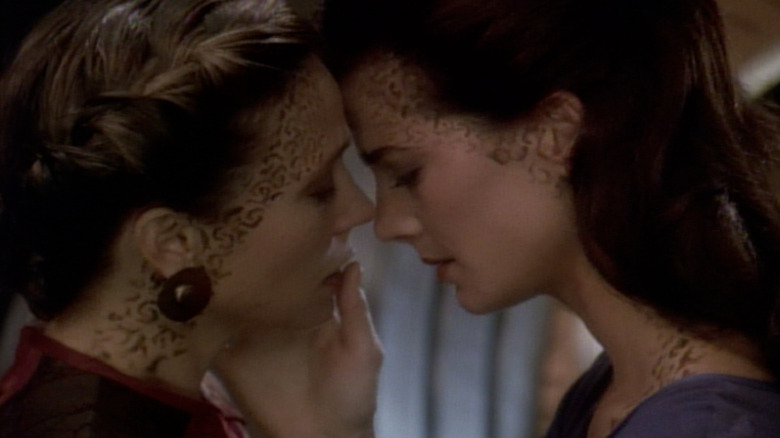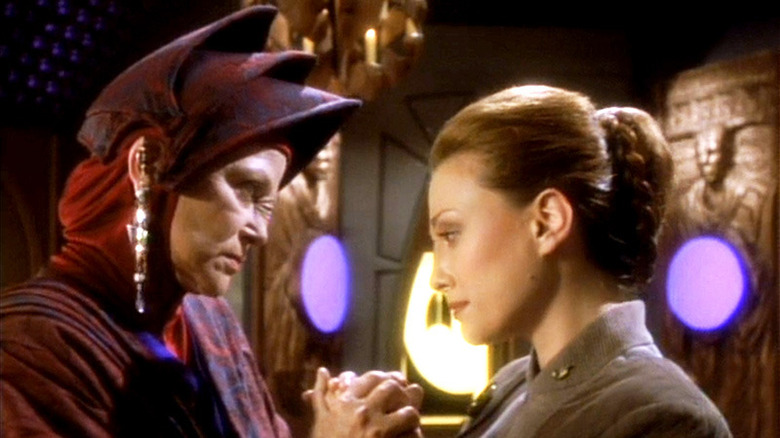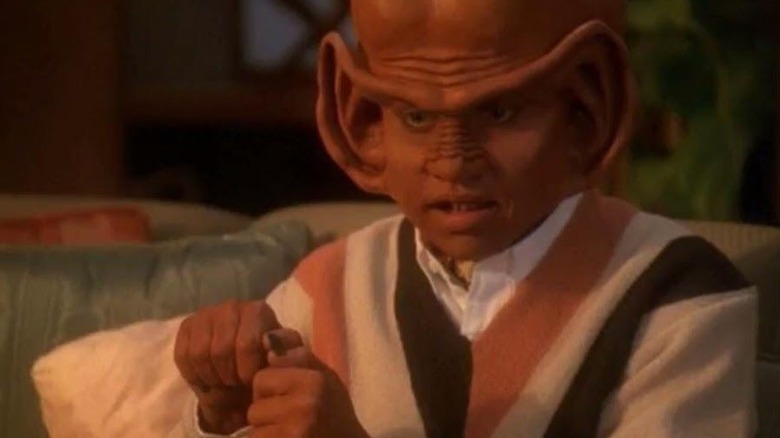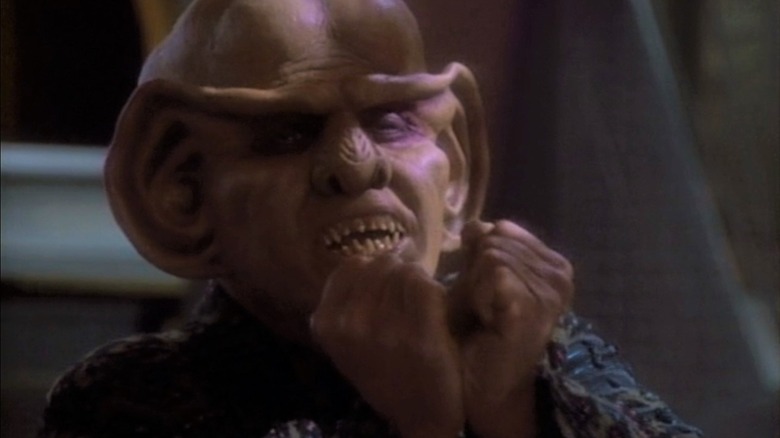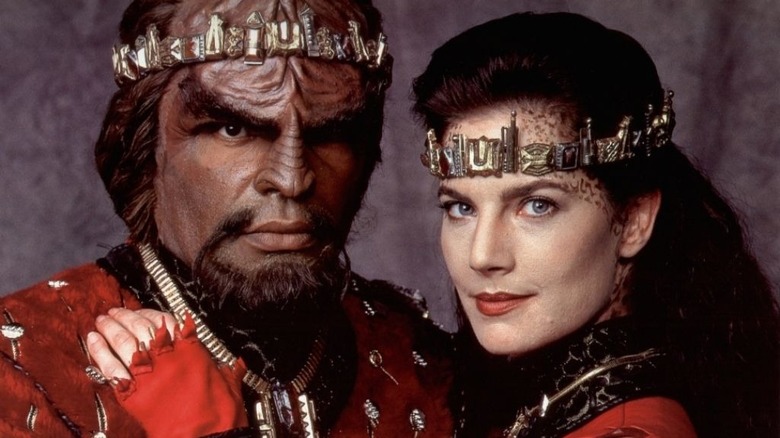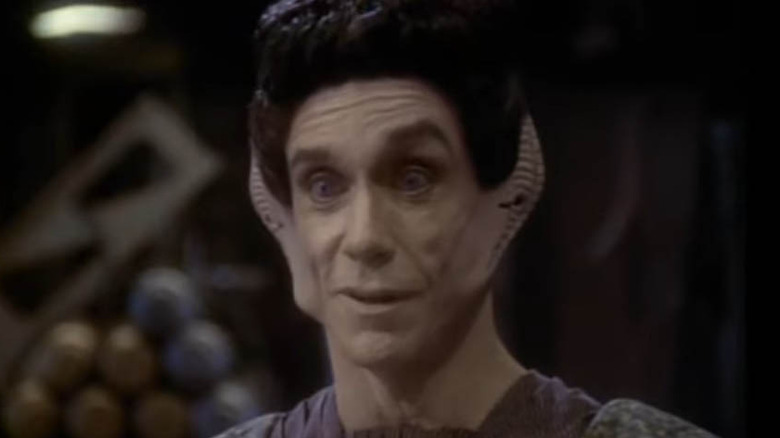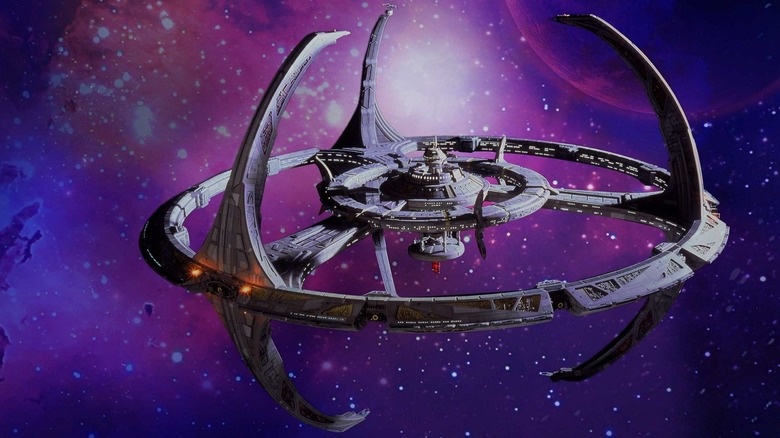13 Reasons Why Deep Space Nine Is The Best Star Trek Show
Stardate: 1991. Brandon Tartikoff, the newly-minted head of Paramount Pictures, was eager to capitalize on the runaway success of "Star Trek: The Next Generation." And so, producers Rick Berman and Michael Piller were tasked with developing a sister series with hardly any directives. Though Piller and Berman were "The Next Generation" veterans with a hardline commitment to "Star Trek" creator Gene Roddenberry's vision for the franchise, it was Roddenberry's untimely passing that ultimately opened new doors for the Trek universe.
The result of Berman and Piller's efforts was "Star Trek: Deep Space Nine," a seminal work of 20th century sci-fi television. In terms of tone, premise, characterization, themes, and execution, the series remains a high-water mark for the franchise. As critic and writer Marc Bernardin noted, "I think 'DS9' never gets quite enough credit for all of the things that it did as incredibly well as it did them and how early they were doing them." Here are 13 reasons why "Star Trek: Deep Space Nine" remains the franchise's finest hour.
It shows a darker side of Trek
One of the principal qualities that sets "Deep Space Nine" apart from previous Trek installments is its embrace of conflict and a muddied morality. The eternal optimism and integrity of Roddenberry's utopian vision was jettisoned like an escape pod by the showrunners. In its place, they established a more mature and nuanced tone.
Over the course of seven serialized seasons, "Deep Space Nine" chronicled a costly, years-long galactic war. One of Roddenberry's core Trek tenets was that it must depict a future free of strife; his Federation had evolved beyond capitalism, racism, sexism, and other societal woes. Burman and Piller had other plans. In the unauthorized oral history "The Fifty-Year Mission: The Next Twenty-Five Years," Piller explained their motivation behind this seismic shift: "It's conflict on every level we could find it." Co-producer Ira Steven Behr, who would take creative control of the series in season 3, elaborated, "There was a whole bubbling cauldron that seemed to take on some new heat ... and we realized we were on a unique show with its own identity."
It features remarkably complex characters
One of the greatest benefits of the serialized nature of "Deep Space Nine" was how it allowed the writers to deepen the characters over the course of its run. As supervising producer David Livingston put it, "The characters on 'Deep Space Nine' were strong, grounded, and diverse." Writer Bradley Thompson went further, saying, "[Behr] always said it's all about character. This is not about whether the 'freck screen demodulator is capable of being realigned with other technobabble.'"
Throughout the series, characters like Kira, Sisko, Worf, Odo, and others struggle with their allegiances as they endure the trials and tribulations of a messy war. They're forced to navigate strategic alliances and confront trauma, grief, and death. Sisko, for example, begins the series as a mournful single father and grows to become a captain, a master diplomat, and, ultimately, a celestial being. In the words of frequent guest star Jeffrey Combs, "[The show] went where no one has gone before. It pursued the journey inside, not the journey out."
It expanded Star Trek's mythology
Since the '60's, "Star Trek" has featured a plethora of different alien races with their own cultures, customs, and beliefs. "Deep Space Nine" explored this to the fullest extent, as its stationary setting allowed for all manner of alien visitors to commingle rather than being happened upon by star-faring explorers.
The series' major contributions to Trek's ever-expanding roster of extraterrestrials include the drug-addicted alien mercenaries known as the Jem'Hadar, the shapeshifting Founders, the mysterious Breen, the Maqui, and the conniving Vorta. The show also fleshed out the cultures, mythology, and doctrines of the previously-introduced Ferengi, Cardassians, Bajorans, Trill, and Klingons. In the case of the latter, resident Klingon-expert and "The Next Generation" carryover Ronald D. Moore ("Battlestar Galactica") took the ball and ran with it, resulting in some truly fantastic episodes.
It reinvigorated characters from Star Trek: The Next Generation
Although "Deep Space Nine" included numerous cameos from "The Next Generation" characters, including the omnipotent trickster Q, the nefarious Klingon sisters Lursa and B'Etor, Lwaxana Troi, Commander William Riker's clone Thomas, and a notably stern Captain Jean Luc Picard, it also shined a big spotlight on two of the preceding series' supporting players: Colm Meaney's Miles O'Brien and Michael Dorn's Lt. Commander Worf.
O'Brien was relatively underused on "The Next Generation," but "Deep Space Nine" created room to flesh out his character, giving him multiple subplots and a charming friendship with the space station's resident doctor, Julian Bashir (Alexander Siddig). Worf's addition to "Deep Space Nine" was mandated by the studio to help boost ratings, but it reaped great benefits for the show. Worf's brief romance with Jadzia Dax proved that she was the perfect, unflappable foil to his eternal gruffness. Viewers were also treated to glimpses of the Klingon warrior's inner tenderness, something "The Next Generation" seldom touched upon.
It's very relevant to modern day concerns
"Star Trek" has always been a vessel for commentary on the issues of its time, from the civil rights movement to the '80s' "Save the Whales" campaign. "Star Trek: Deep Space Nine" carried this tradition into the '90s, and even predicted some turn-of-the-century anxieties. Looking back, it seems even more prescient than ever.
With the exception of Nicholas Meyer's two original series films and a handful of episodes of "The Next Generation," the concept of Starfleet as a militarized organization has largely been ignored. "Star Trek: Deep Space Nine" flipped the script on that notion, plunging the Federation into the Dominion War. Moral compromises became the order of the day, and agita about imperialism and the fear of the other took precedence in what had previously been an anodyne franchise.
When Starfleet declares martial law on Earth in the two-part "Homefront" and "Paradise Lost," 21st-century viewers will recall the establishment of the Department of Homeland Security, the Patriot Act, and the catastrophic wars in Afghanistan and Iraq in the wake of 9/11. Another key episode, "The Darkness and the Light" (written by "Hannibal" mastermind Bryan Fuller), deftly interrogates the consequences of terrorism.
It has a major focus on family
"Star Trek" has always centered on a makeshift family of sorts — primarily, the found families of the main crews of the Enterprise NCC-1701 and NCC-1701-D — but familial concerns are the heart of "Deep Space Nine." The bond between widowed Commander-turned-Captain Benjamin Sisko and his son Jake is one of the series' greatest strengths. In the crowd-funded retrospective documentary "What We Left Behind," actress Felicia Bell Rutkowski (who played Sisko's late wife, Jennifer) stated, "He was creating a role model, particularly for African American men, for how to treat your son."
The heart-rending season 4 episode "The Visitor" depicts an aged Jake Sisko (played by Trek regular Tony Todd) living in seclusion in Louisiana, mourning the death of his father. Sci-fi hijinks ensue, but the emotionality of the episode, which was directed by "Deep Space Nine" stalwart David Livingston, is profound. Brooks' chemistry with Jake Sisko actor Cirroc Lofton extended beyond the set, too — Brooks even introduced Lofton to acquaintances as his son — and it shows.
It introduces a more diverse quadrant
Star Trek is one of the more unique sci-fi franchises when it comes to representation, and "Deep Space Nine" is no exception. It carried on the franchise's legacy of including BIPOC and LGBTQ+ characters, boldly going where no entry in the saga had gone before in terms of diversity.
Obviously, centering the show on an African American lead was a progressive choice, particularly in the early '90s. As Armin Shimerman, who played Quark, observed at a Galaxy Con event, "I think one of the legacies of the show is [Brooks'] performance and what they wrote for him to demonstrate the problems of being Black in basically a white and orange society." Captain Benjamin Sisko's nobility and empathy in raising his son Jake resonated with cast members and viewers alike.
Additionally, "Deep Space Nine" was a landmark for televised queer representation. The Trill species allowed Trek to explore queer issues. The species often served as a fairly clear metaphor for the trans experience, while in the season 4 epsiode "Rejoined," Jadzia Dax (who used to occupy a male body) and their old flame (who lives in a female host) share a kiss; remarkably, it was the fifth-ever lesbian kiss in the history of American TV.
It opened Star Trek up to examinations of religion
Gene Roddenberry was famously a secular humanist, and many of the Trek stories told under his supervision featured false prophets or impish, seemingly indifferent deities like Q; who could forget "Star Trek V: The Final Frontier" and the immortal line, "What does God need with a starship?" However, the franchise rarely touched on alien religions. The emphasis on the Bajoran race in "Deep Space Nine" allowed the creators to change that, delving much deeper into issues of faith than Trek's previous explorations of, say, the religious side of the Vulcan and Klingon cultures.
The Bajorans of "Deep Space Nine" are polytheists who believe that the alien race occupying the wormhole that Deep Space Nine is located next to are prophets who are guiding everyone in the universe. To the Bajorans, the wormhole is a "Celestial Temple," and Captain Benjamin Sisko is fated to be the "Emissary" to the Bajoran prophets. Such an overt acknowledgement of religion was heretofore unseen in Trek; contemporary series like "Star Trek: Discovery" have further explored faith as a central element in their storylines.
It explores the consequences of war
The Dominion War presented "Star Trek: Deep Space Nine" with the opportunity to explore both the triumphs and tragedies of warfare. Unlike the relatively bloodless "The Next Generation," the high stakes of "Deep Space Nine" meant that virtually anyone was at risk of serious injury or death.
This was best exemplified in the tragic arc of Nog (Aron Isenberg), son of the Ferengi Rom. Nog proudly became the first member of his race to enlist in Starfleet, and served aboard Deep Space Nine's warship, the Defiant, after graduating from the Academy. During the Siege of AR-558, Nog was gravely wounded in a battle with the Jem'Hadar, losing one of his legs.
"Deep Space Nine" proceeded to sensitively explore the fallout of this event. Nog's subsequent post-traumatic stress disorder was thoughtfully and powerfully spotlighted in the season 7 episode "It's Only a Paper Moon," which saw Nog retreating into a fantasy world on the holodeck to avoid confronting the harsh realities of his condition.
It has a sense of humor
Despite its dark tone, "Deep Space Nine" still made time to bring a sense of fun to its proceedings. Where the original "Star Trek" was sometimes intentionally humorous and "The Next Generation" dabbled in sillier stories, "Deep Space Nine" often took a break from the relentless tension of the Dominion War to mine its cast of colorful personalities for some much-needed laughs.
Some of this humor resulted from the garrulous Cardassian tailor Garak, but most of it came at the expense of Ferengi bartender Quark, who was constantly scheming and getting in over his head. In his interactions with his brother Rom, the station's chief of security Odo, and the Grand Nagus, Quark was always the butt of the joke.
The humor of "Deep Space Nine" reached its apex in the season 6 episode "The Magnificent Ferengi," in which Quark leads a bumbling team of Ferengi on a rescue mission to save his "moogie" Ishka. The episode features some of Rom's funniest moments and a climax that homages "A Weekend at Bernie's." Other comedic episodes include the baseball story "Take Me Out to the Holodeck," "Little Green Men," and "Trials and Tribble-ations," an episode that pays homage to the original series.
It was committed to romance
The episodic nature of the original series and "The Next Generation" allowed for a lot of fleeting moments of lascivious behavior from characters like Captain James T. Kirk and William Ryker, as well as the ongoing romantic tension between Captain Jean Luc Picard and Dr. Beverly Crusher, but "Deep Space Nine" benefited from being able to chronicle human and interspecies relationships over a longer period of time.
This was best expressed in the relationship and eventual wedding of Lt. Worf and science officer Jadzia Dax, but "Star Trek: Deep Space Nine" also treated viewers to Captain Sisko's endearing romance with Kassidy Yates and Ezri Dax's marriage to Julian Bashir. Miles O'Brien and his wife Keiko were also blessed by the "Deep Space Nine" writers with an expanded look at their coupling. Major Kira Neyrs served as a surrogate for the O'Brien's firstborn child, Kirayoshi (a clever workaround for actress Nana Visitor's real-life pregnancy). "Star Trek: Deep Space Nine" also had its own Sam and Diane dynamic between Kira and Odo, which lent great emotional resonance to the series finale.
It featured lots of memorable guest stars
In all fairness, when it comes to Trek, "Deep Space Nine" is not unique in having a wealth of great cameos and recurring guest characters. That being said, a number of fantastic actors cropped up across its seven seasons, from the charmingly random (punk rock icon Iggy Pop, seen above playing a Vorta) to the more expected (the aforementioned "The Next Generation" cast members).
Special recognition must be paid to the great Jeffrey Combs ("Re-Animator"), who played five different characters on "Deep Space Nine." His most prominent role was that of the villainous Vorta Weyoun and his various clones, but he also portrayed the Ferengi Brunt on multiple occasions, as well as Quark's business partner Tiron and an unnamed holosuite guest in the series finale, "What You Leave Behind." Finally, Combs memorably appeared as a racist police officer in the widely praised episode "Far Beyond the Stars," a trippy, profound examination of racial injustice set in 1950s America; notably, the episode was directed by Benjamin Sisko himself, Avery Brooks.
It introduced a bold new aesthetic to the franchise
One of the most obvious ways that "Star Trek: Deep Space Nine" distinguishes itself from other Trek media is in its design. The Enterprise of the original series was redolent of other '60s-era sci-fi: clean, sleek, and minimal. "The Next Generation" opted for a soothing, antiseptic palette made up of soft colors and lighting — a kind of Marriott hotel in space, if you will. The setting of "Deep Space Nine," however, presented its creators with the chance to explore a new aesthetic in the Trek universe. The titular station was designed by Cardassians, and the Starfleet personnel necessarily appeared out of place amongst the alien architecture.
Production designer Herman Zimmerman was responsible for the memorable look of the space station. Needless to say, Zimmerman, along with his team of model-makers (including Nathan Crowley, who would go on to be the production designer for "Westworld" and many Christopher Nolan projects) accomplished their goal in making an instantly recognizable design. Equally impressive are the massive interior sets of "Deep Space Nine," including its sprawling promenade and Quark's bar.
